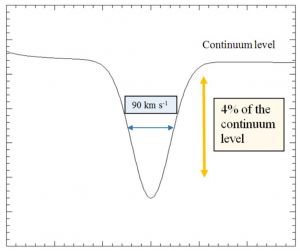2018年IOAA理论第9题-射电星系
本题目目前没有解答。要不要你来试试! |
|
英文题目
(T9) Radio Galaxy (25 points)
An observer wants to use the Five-hundred-meter Aperture Spherical radio Telescope (FAST) in China to observe a radio galaxy at redshift of 𝑧 = 0.06. We assume that the radio source is compact compared to the beam size of the telescope at the observing frequencies, i.e., the source is point-like as seen through the telescope. To detect a point source with FAST, it must be sufficiently strong (bright) relative to the noise level (for single polarization observations), σ, which depends on the bandwidth, △ν, and the integration time (the radio astronomy equivalent of exposure time), ti, as follows:
$$\sigma=\frac{2k_B T_{sys}}{A_e\sqrt{t_i \Delta\nu}}$$
where Tsys is the system temperature (about 150 K in the frequency range of 0.28 GHz – 0.56 GHz and 25 K in the frequency range of 1.05 GHz – 1.45 GHz), and Ae = 4.6x104 m2 is the effective area of the telescope taking into account the total efficiency of the instrument.
This radio galaxy has an observed continuum flux density of fν = 2.5 × 10−3 Jy at an observing frequency of 0.4 GHz. The bandwidth △ν for the continuum observation centered at 0.4 GHz is 2.8×108 Hz.
(a) In order to detect the continuum flux density at 0.4 GHz with a signal-to-noise ratio of 30 (a so-called 30σ detection), what is the required integration time, ti?
(b) We want to search for the neutral Hydrogen (HI) in the galaxy using 21cm absorption line. The HI 21cm line, with rest frame frequency of 1.4204 GHz. Calculate the observed frequency (νobs) of the HI line for this galaxy.
(c) The radio continuum emission from this galaxy can be described by a power law $$f_\nu\sim \nu^\alpha$$ , with a spectral index of α = −0.2. Calculate the continuum flux density at vobs for this galaxy.
(d) The line width of the HI 21cm absorption line is 90 km/s. Calculate the line width in Hz at the observing frequency of vobs. According to Figure 1, the HI 21cm line absorbs 4% of the continuum flux density (on average) over the line width of 90 kms-1. In order to detect the absorption line at ≥3σ in three consecutive 30 kms-1 channels, what is the required integration time?
中文翻译
(T9) 射电星系 (25分)
一个观测者希望用中国的FAST观测一个红移z = 0.06的射电星系。我假设这个射电源相对于这个频率的波束是致密的,也就是说,这个源在望远镜看起来是一个点。信号需要相对于噪声足够强才能被FAST探测到,而(单偏振观测的)噪声σ取决于带宽△ν和积分时间(射电天文中的曝光时间)ti,关系如下:
$$\sigma=\frac{2k_B T_{sys}}{A_e\sqrt{t_i \Delta\nu}}$$
其中Tsys是系统的噪声温度(在0.28 GHz – 0.56 GHz约为150 K,在1.05 GHz – 1.45 GHz约为25 K),Ae = 4.6x104 m2是考虑所有仪器效率后望远镜的等效接收面积。
之前的观测显示这个射电星系在0.4 GHz具有fν = 2.5 × 10−3 Jy的连续谱。这次观测的中心频率是0.4 GHz,带宽是2.8×108 Hz。
(a) 需要多久的积分时间ti,才能在0.4GHz以30的信噪比(也就是所谓的30σ准则)探测到连续谱?
(b) 我们希望寻找星系中的中性氢(HI)21厘米吸收线。中性氢21厘米谱线静止参考系频率为1.4204 GHz。计算观测这个星系的HI吸收线需要的频率νobs。
(c) 这个射电星系的连续谱可以用幂律关系描述$$f_\nu\sim \nu^\alpha$$,其中谱指数α = -0.2。计算连续谱在观测频率νobs处的流量。
(d) 中性氢(HI)21厘米的吸收线线宽为90 km/s。计算在观测频率处,以赫兹为单位的线宽。根据图1,中性氢21厘米谱线在90 kms-1的宽度上平均吸收了4%的连续谱。为了在三个连续的30 kms-1频道中以3σ探测到这条谱线,需要多少的积分时间?

